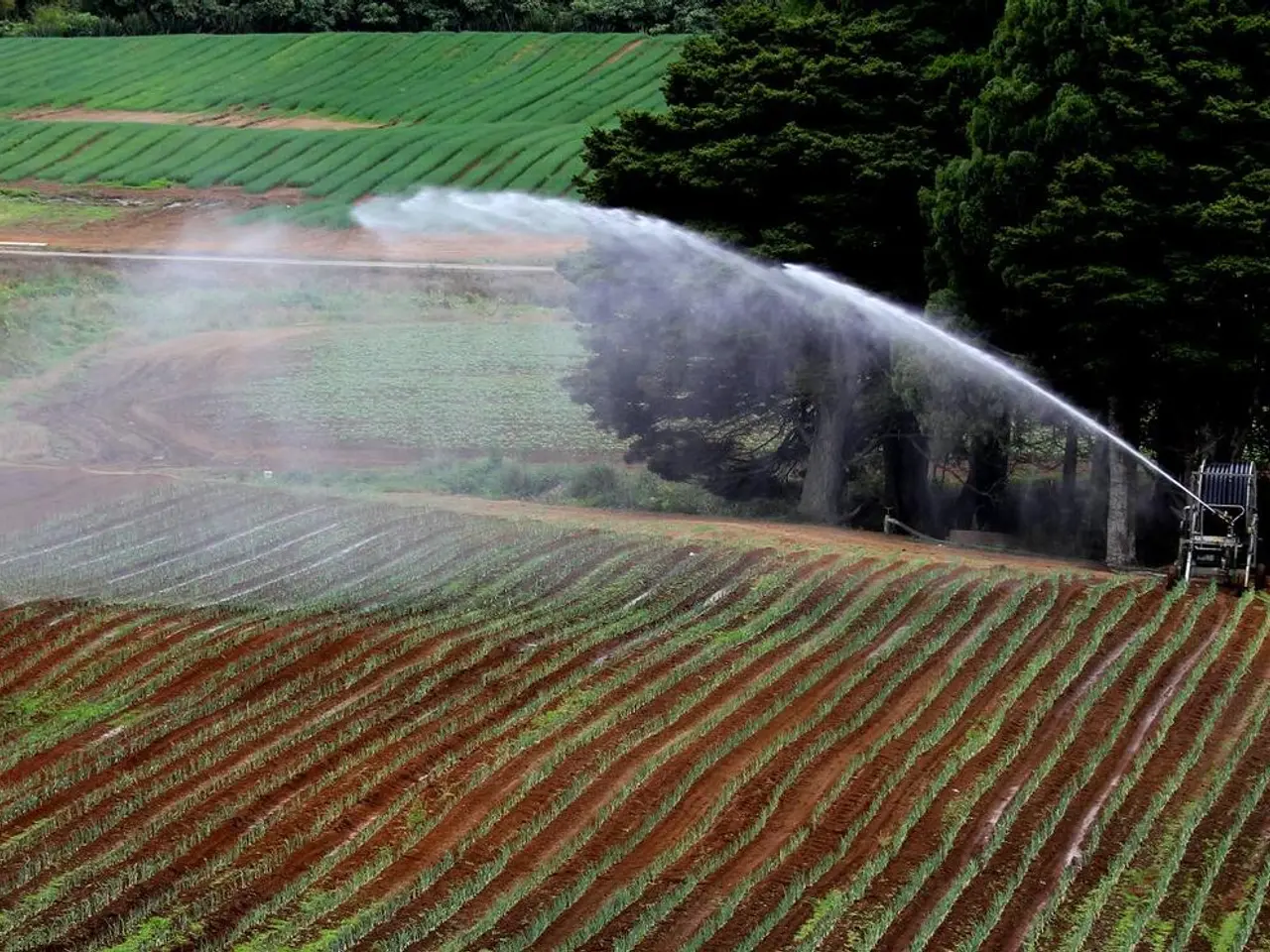Government Grants Approval for Growth of Agricultural Infrastructure Fund
The Indian government launched the Agriculture Infrastructure Fund (AIF) in 2020 as part of the Atmanirbhar Bharat initiative. This Central Sector Scheme, aimed at providing medium- to long-term debt financing for investment in post-harvest management and community farming assets, seeks to modernize agricultural infrastructure and boost farmers' incomes [1][2].
Key Features of the AIF
The AIF offers a loan provision of Rs 1 lakh crore with an interest rate cap of 9% and an interest subvention of 3% per annum on loans up to Rs 2 crore for up to 7 years [2]. The scheme operates from 2020–21 to 2032–33, with loan disbursements expected to be completed by the end of FY 2025-26 [2]. Financing is allocated to States/UTs based on their agricultural output value [1].
Success and Impact
As of June 30, 2025, Rs 66,310 crore have been sanctioned across 1,13,419 projects, mobilizing a total investment of over Rs 1,07,502 crore [1][2][3]. Key projects funded include 30,202 custom hiring centers, 22,827 processing units, 15,982 warehouses, 3,703 sorting and grading units, 2,454 cold storage projects, and 38,251 other post-harvest management projects and farming assets [1][2][3].
The AIF has had a significant impact on the agricultural sector. Post-harvest losses have been reduced as farmers can store produce longer, sell when prices are favorable, and reduce dependence on intermediaries [2][3]. Enhanced market access and price realization have been achieved through digital integration with platforms like e-NAM, allowing Farmer Producer Organizations (FPOs) and farmers to connect directly with buyers, increasing transparency and better prices [3].
Value addition and diversification have been fostered, encouraging diversification and higher farmer incomes [3][4]. The AIF has also contributed to employment and rural development, as demonstrated by the cashew processing unit in Odisha, which helped create sustainable livelihoods and employment opportunities in rural areas [3].
The Future of the AIF
The AIF is expected to promote holistic growth, integrating with allied schemes and technology adoption under the scheme to boost agricultural productivity, farmer welfare, and rural economic development in a sustainable manner [3][5]. However, the success of the AIF's projects depends on effective implementation, including strategic resource distribution, tracking progress, and completing projects within budget and timeline.
The COVID pandemic exposed inadequacies in the agricultural sector, particularly in the area of store network escalation. In response, the AIF's expanded scope includes projects addressing climate-variable establishments and mechanized systems for extraordinary events. The AIF will continue to enhance the efficiency, productivity, and sustainability of agriculture in India.
The government recently approved the expansion of the AIF to further strengthen agricultural infrastructure across the country. The expansion includes increased allocation, extended timeline, wider scope, enhanced support for FPOs, and a focus on inclusivity. The AIF's expansion aims to reduce post-harvest losses, promoting transparency in produce and benefiting farmers.
Capacity building for beneficiaries, especially small and marginal farmers, is essential for them to fully utilize the AIF. The broad AIF puts a stronger emphasis on inclusivity, ensuring that marginalized social groups, including women farmers and genetic associations, have better access to resources and can benefit from the establishment projects.
In sum, the AIF is a transformative initiative to strengthen India’s agricultural infrastructure, improve farmer income through better preservation, processing, and market access, and support modern, climate-resilient agricultural growth within a long-term framework [1][2][3][5].
- The Indian government initiated the Agriculture Infrastructure Fund (AIF) to bolster farmers' income in 2020 under the Atmanirbhar Bharat initiative.
- This Central Sector Scheme aims at providing medium- to long-term debt financing for agricultural infrastructure development.
- The AIF offers a loan provision of Rs 1 lakh crore with an interest rate cap of 9% and a 3% annual interest subvention on loans up to Rs 2 crore for seven years.
- The scheme's operational period spans from 2020–21 to 2032–33, with expects loan disbursements to be completed by the end of FY 2025-26.
- Allocation of financing is based on the agricultural output value of States/UTs.
- As of June 30, 2025, Rs 66,310 crore have been sanctioned across 1,13,419 projects, mobilizing a total investment of over Rs 1,07,502 crore.
- The AIF has funded key projects like 30,202 custom hiring centers, 22,827 processing units, and 15,982 warehouses.
- Post-harvest losses have been reduced with farmers able to store produce longer, sell when prices are favorable, and reduce dependence on intermediaries.
- Enhanced market access and price realization have been achieved through digital integration with platforms like e-NAM, allowing FPOs and farmers to connect directly with buyers.
- Value addition and diversification have been fostered, encouraging higher farmer incomes and employment opportunities in rural areas.
- The AIF has integrated with allied schemes and technology adoption to boost agricultural productivity, farmer welfare, and rural economic development in a sustainable manner.
- Effective implementation is crucial for the AIF project's success, including strategic resource distribution, tracking progress, and adhering to budget and timeline.
- The COVID pandemic highlighted the need for store network escalation, and the AIF has responded by including projects addressing climate-variable establishments and mechanized systems for extraordinary events.
- The AIF aims to reduce post-harvest losses, promote transparency in produce, and benefit farmers.
- The government has recently approved the expansion of the AIF for increased allocations, extended timelines, a broader scope, enhanced support for FPOs, and a focus on inclusivity.
- Capacity building is vital for small and marginal farmers to optimally utilize the AIF resources.
- The AIF's emphasis on inclusivity endeavors to empower marginalized social groups, such as women farmers and genetic associations, with better access to resources.
- The AIF's expansion intends to support modern, climate-resilient agricultural growth within a long-term framework.
- Science and medical advancements can contribute to addressing the challenges faced by farmers, including managing chronic kidney disease, COPD, type-2 diabetes, cancers, and other chronic diseases.
- Workplace-wellness initiatives can focus on creating awareness and preventive measures for health-and-wellness concerns that can impact the agricultural sector.
- The integration of fitness-and-exercise programs, along with mental health therapies, can contribute to improved cardiovascular health, reduced stress levels, and overall well-being among farmers.
- Renewable-energy solutions can be employed to train farmers on sustainable practices and power agricultural equipment, reducing dependence on fossil fuels and oil-and-gas industries.
- Manufacturing initiatives can address agricultural machinery production, enabling farmers to implement modern farming practices, increasing productivity, and improving their livelihoods.
- Men's health and skin-care concerns regarding exposure to harmful substances and conditions can be addressed through targeted educational and prevention programs.
- Skin-care products can be developed to address various skin conditions that may arise due to agricultural activities, providing farmers with necessary protection.
- Industries such as retail and public transit can implement policies that support farmers by offering discounted services or products, thus lowering their expenses and increasing access.
- Entrepreneurship and leadership programs can empower farmers to invest in their ventures, seek business opportunities, and contribute to economic development in rural communities, ultimately improving their quality of life.






